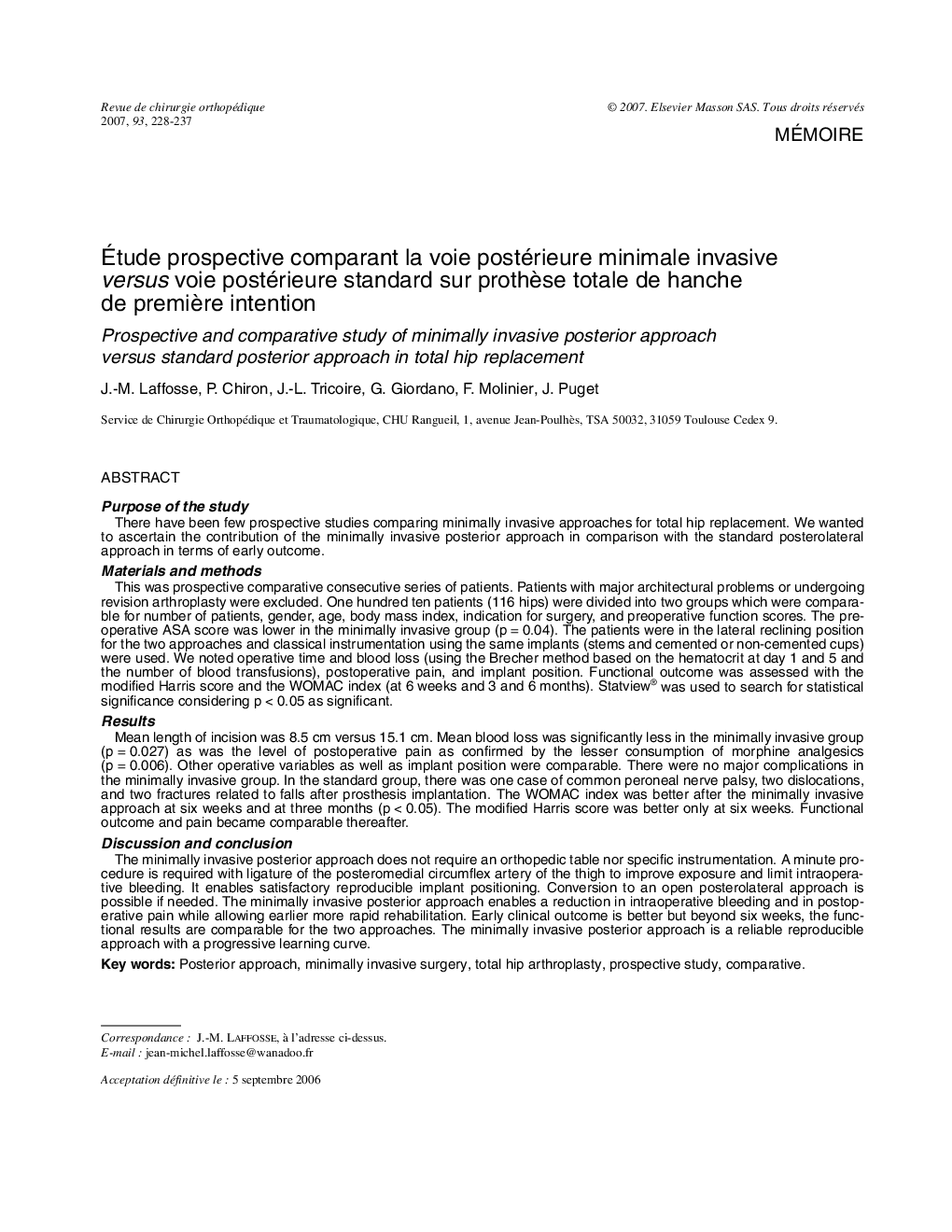| کد مقاله | کد نشریه | سال انتشار | مقاله انگلیسی | نسخه تمام متن |
|---|---|---|---|---|
| 4088888 | 1268115 | 2007 | 10 صفحه PDF | دانلود رایگان |

RésuméNous avons réalisé une étude prospective, continue et comparative afin de rechercher l’intérêt d’une voie postérieure minimale versus une voie postéro-latérale « standard » dans les arthroplasties totales de hanche.Cent-seize arthroplasties réparties en deux groupes d’effectif égal et comparables en préopératoire ont été incluses. Nous avons exclu les troubles architecturaux majeurs et les arthroplasties de reprise. Les deux voies ont été réalisées avec une instrumentation classique et le même type d’implant. Nous avons étudié la durée opératoire, le saignement opératoire (calculé grâce à l’hématocrite pré et postopératoire et aux transfusions sanguines), la douleur postopératoire et le positionnement des implants. Les résultats cliniques fonctionnels ont été évalués (score de Harris modifié et Womac permettant une auto-évaluation) à 6 semaines, 3 et 6 mois. Le seuil de significativité retenu était p < 0,05.La longueur moyenne de l’incision était de 8,5 cm versus 15,1 cm. Les pertes globulaires moyennes calculées étaient significativement plus faibles dans le groupe mini-voie (p = 0,027) ainsi que la douleur postopératoire confirmée par une moindre consommation d’antalgiques morphiniques (p = 0,006). Les autres paramètres opératoires et le positionnement des implants étaient comparables. Aucune complication majeure n’a été relevée dans le groupe mini-voie. Dans l’autre groupe, une parésie du nerf fibulaire commun, deux luxations et deux fractures sur prothèse lors de chute ont été observées. L’index de Womac était meilleur après mini-abord à 6 semaines et 3 mois (p < 0,05), le score de Harris modifié était meilleur à 6 semaines seulement. Par la suite, les résultats fonctionnels devenaient comparables.
Purpose of the studyThere have been few prospective studies comparing minimally invasive approaches for total hip replacement. We wanted to ascertain the contribution of the minimally invasive posterior approach in comparison with the standard posterolateral approach in terms of early outcome.Materials and methodsThis was prospective comparative consecutive series of patients. Patients with major architectural problems or undergoing revision arthroplasty were excluded. One hundred ten patients (116 hips) were divided into two groups which were comparable for number of patients, gender, age, body mass index, indication for surgery, and preoperative function scores. The preoperative ASA score was lower in the minimally invasive group (p = 0.04). The patients were in the lateral reclining position for the two approaches and classical instrumentation using the same implants (stems and cemented or non-cemented cups) were used. We noted operative time and blood loss (using the Brecher method based on the hematocrit at day 1 and 5 and the number of blood transfusions), postoperative pain, and implant position. Functional outcome was assessed with the modified Harris score and the WOMAC index (at 6 weeks and 3 and 6 months). Statview® was used to search for statistical significance considering p < 0.05 as significant.ResultsMean length of incision was 8.5 cm versus 15.1 cm. Mean blood loss was significantly less in the minimally invasive group (p = 0.027) as was the level of postoperative pain as confirmed by the lesser consumption of morphine analgesics (p = 0.006). Other operative variables as well as implant position were comparable. There were no major complications in the minimally invasive group. In the standard group, there was one case of common peroneal nerve palsy, two dislocations, and two fractures related to falls after prosthesis implantation. The WOMAC index was better after the minimally invasive approach at six weeks and at three months (p < 0.05). The modified Harris score was better only at six weeks. Functional outcome and pain became comparable thereafter.Discussion and conclusionThe minimally invasive posterior approach does not require an orthopedic table nor specific instrumentation. A minute procedure is required with ligature of the posteromedial circumflex artery of the thigh to improve exposure and limit intraoperative bleeding. It enables satisfactory reproducible implant positioning. Conversion to an open posterolateral approach is possible if needed. The minimally invasive posterior approach enables a reduction in intraoperative bleeding and in postoperative pain while allowing earlier more rapid rehabilitation. Early clinical outcome is better but beyond six weeks, the functional results are comparable for the two approaches. The minimally invasive posterior approach is a reliable reproducible approach with a progressive learning curve.
Journal: Revue de Chirurgie Orthopédique et Réparatrice de l'Appareil Moteur - Volume 93, Issue 3, May 2007, Pages 228-237